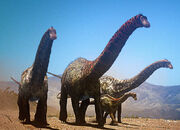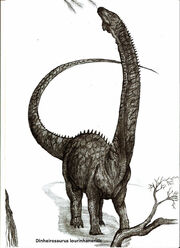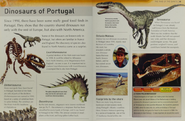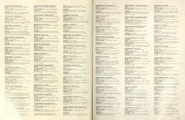Dinheirosaurus (din-HY-row-SORE-us) was a member of the sauropod family known as the diplodocids that lived in Europe during the Late Jurassic Period.
Discovery and naming[]
In 1987 a team of scientists came across a bonebed in the cliffs of Porto Dinheiro Lourinha in Portugal that revealed the habitat of a water hole-type environment.

Dinosaur Revolution Dinheirosaurus
In this fossil-rich gravel there the unmistakable bones of a sauropod were found in 1992. They were examined in 1999 and were found to be a new species of diplodocid. It was dubbed Dinheirosaurus lourinhanensis (Porto Dinheiro lizard from Lourinha), and offered new intel as to what life during the Jurassic Period in Europe may have held. It was also found alongside several specimens of predators like Allosaurus and the vicious Torvosaurus, smaller reptiles like Ornitholestes and Rhamphorhynchus, and even a long-necked, spikey stegosaur called Miragaia.

Dinheirosaurus Vertebrae
Description[]
Classification[]
Paleobiology[]
Like other diplodocids, Dinheirosaurus was relatively very long and slender.

It's neck was very extended and at the end of it was a small head with peg-like teeth designed for stripping the vegetation off ferns. From a few vertebrae it's been estimated to have been roughly 70–80 feet (21.5-24.6) meters long and weigh about 15 tons. Although it's true length is unknown, scientists can say with quite a bit of confidence that the tail was about 35 feet (10.8 meters) long and was capable of acting like a whip when needed against either predators or rivals. Like all other large, Late Jurassic sauropods, Dinheirosaurus was a quadruped, and moved around on four thick but slow-moving legs. It also likely migrated with other herd members from watering hole to watering hole to keep themselves sustained with enough food and water, and since they were so large, they needed a lot of it. One feature that it shares with other diplodocids is that it likely had spines that ran down its back and it probably swallowed stones called gastroliths to help aid it in digestion.
Paleoecology[]
In popular culture[]
Dinheirosaurus was featured in the 2011 television series Dinosaur Revolution, where one male individual sauropod named Woodstock whipped a baby Allosaurus named Broken Jaw and broke his lower jaw, but it returned later with its herd and the broken-jawed theropod got his revenge by biting off the end of his tail. A few days later a Torvosaurus arrives at the water hole and drives Broken Jaw the Allosaurus out before trying to kill Woodstock the Dinheirosaurus and his baby. But it's intimidated by the giant sauropod and in backing up nearly steps on a baby Miragaia, which causes the adults to join the fight before the megalosaurid tackles the adult Dinheirosaurus and goes after the retreating juvenile. But as it’s fighting with the juvenile, the Allosaurus returns and attacks the Torvosaurus by holding onto its neck before being thrown off and the adult Dinheirosaurus comes to the rescue and finishes it off by crushing the megalosaurid under its weight. A few weeks later a herd of huge Lustotitan comes and drinks the last of the water, causing the Dinheirosaurus herd to migrate off again.
Gallery[]
References[]
Websites:
http://dsc.discovery.com/tv/dinosaur-revolution/photos/watering-hole-pictures-03.html
http://en.wikipedia.org/wiki/Dinheirosaurus
http://www.prehistoric-wildlife.com/species/d/dinheirosaurus.html
Documentaries:
Dinosaur Revolution


